Yes, we’ve been on a bit of a Hurstville bender recently, but it’s all been leading up to this. This is arguably the defining story of a suburb intrinsically linked to its biggest resident. The story of Hurstville cannot be told without Westfield, and vice versa. It’s a long story spanning 150 years and a lot of parking spaces. Get comfy – it’s one of those ones. And away we go…
I was dreaming of the past…
Our story begins in the 1870s, at which time the St George area was home to a grand total of 2038 happy people. Suburbs such as Lugarno, Oatley, Bexley and Kingsgrove had been growing steadily for a few decades. In the midst of all this action was a large, heavily timbered area scandalously known as Lord’s Bush (after its longtime owner, Simeon Lord).
Purchased by a Michael Gannon in 1850, the area was renamed Gannon’s Forest, and the road running through the forest from Lugarno to Tempe was renamed Gannon’s Forest Road. See where this is going? The area got its first frothy taste of the commercial life in the early 1850s when – wait for this – a PUB was built. Turns out pubs and the seedy goings-on within attract people, and soon the people came. By 1864 a post office had arisen beside the Blue Post Inn, and was later joined by another pub (the Currency Lass, later the Free and Easy), a bakery (but not that bakery), and some other exciting retail outlets. A growing population means breeding, and that means kids, and kids means education (most of the time), so in 1876 a decision was made to erect a school for dem kidz wat cudnt spel ore reed no gud. A forward thinking inspector suggested the school be named Hurstville, and because it’s undeniably catchy, it stuck. Soon the post office was renamed thusly, and the population continued to grow.
Until the mid-1880s, the development of the town had centred around that original pub, the Blue Post Inn, which had become an unofficial meeting place for town development discussions and the like. It was during one of those meetings that a railway station was proposed, and if those walls could talk, I feel certain they would have uttered “Well, shit.”
Hurstville Station was built in 1884, one kilometre away from the pub. Businesses changed tack accordingly, and suddenly no one cared about the Blue Post. Perhaps it would have preferred being instantly euthanised like the Free and Easy, which was resumed to make way for the train station. Instead, the Blue Post had its licence transferred to the nearby White Horse Hotel – the greatest dishonour a pub can experience. More like the White Flag Inn, right?
The advent of the public transport hub was like the shot from a starting gun. Hurstville just couldn’t, wouldn’t, be stopped. It became a municipality in 1887, a local newspaper started up (the St George Observer, NOT The Leader, although you could be forgiven for thinking it had been around that long), those big expensive looking mansions were being built all over the place. Even a bank crash/mini depression in 1893 was made less severe by the commercial area that had prospered in the area surrounding the train station.
The land opposite Hurstville Station was swampy marsh named ‘Frog Hollow’. Originally one of the sources of Bardwell Creek, it had been further softened by runoff from both the station and the increasingly busy Forest Road. But Hurstville’s insatiable need for retail saw the swamps drained in 1907 to make suitable foundations for an all new concept in shopping – Croft’s, a two-storey building with four shops within. Why…that means I could get FOUR times the shopping done AT ONCE!
One of these shops was occupied by a mercer named Bert Jolley, who would later describe himself as “a young man with more confidence than money”. Success wasn’t instant; three months after opening, Jolley’s ledger recorded this lacklustre return: ‘Total Customers, 1; Total Sales, 1’, despite being open from 7am to 8pm.
The story goes that Jolley, despondent and faced with bankruptcy, found himself moping around the city looking for a cup of coffee. He ended up at the Black Cat Cafe beneath Her Majesty’s Theatre, and as he drank his black coffee he was transfixed by the walls of the cafe, which were plastered in pictures of black cats. In his crazed desperation, Jolley became convinced the black cat was his spirit animal and good luck charm, and immediately devised a ‘Lucky Black Cat Sale’ for his store. Amazingly, the gamble paid off: by 1910 he’d bought the whole building, leaving both he and his variety-starved customers very jolly indeed.
Jolley’s success as a suburban department store inspired plenty of copycats (heh); in 1917 local trader Diments, a hardware and produce store, expanded in size to rival Jolley, while 1921 saw the advent of Barter’s, a rival department store.
In a tale so similar to Jolley’s that these days copyright lawyers would be involved, Charles Barter bought a single-storey shop at the approximate location of the former ANZ Bank on Forest Road. Before long it wasn’t enough, so Barter very shrewdly bought a piece of land beside the entrance to the railway station with the intention of building the greatest department store the suburbs had ever known.
Can I just interrupt the narrative for a moment to ask where Hurstvillians were getting all this money to spend with these guys? Like maybe you wouldn’t have had to live on a swamp filled with frogs if you’d invested in making your town nice instead of buying hats and black armbands or whatever it was they bought back in those days.
Anyway, during excavation for his wonderful new three-storey building, Barter unearthed an old horseshoe, which he hung in his office for luck. Yes, Barter was such a plagiarist he even swiped Jolley’s good luck charm concept. But Barter would get a taste of his own medicine in 1922 when the Allen brothers opened their own department store (with an emphasis on menswear) further up Forest Road.
Now, do you think that’s enough department stores? Let’s review – at this point, there’s Barter’s, Diments, Jolley’s and Allen Bros., all on Forest Road, all creepily surrounding the station like vultures. Spoiled for choice much, Hurstville? Wouldn’t it be more convenient if, oh, I dunno, they were able to combine many stores and even department stores into one giant superstore?
Jolley was somehow able to stave off these attacks, maintaining a healthy profit throughout. Healthy enough to – you guessed it – expand yet again in 1933. Jolley had grown tired of paying council rates for his ever-expanding shop frontage on Forest Road, so in an ingenious move, he dug out an arcade of shops beneath his existing building, allowing for several new businesses without having to pay any excess rates. The move opened Hurstville’s eyes to the idea of an even greater shopping experience at the expense of cutting into the heart of Hurstville itself. But you can’t make an omelette without breaking some eggs, right?
Jolley’s clever tactic paid off so well that he was able to retire in 1937, selling his 24-shop building and arcade to Woolworths. While at the time it was seen as a ‘local boy done good’ success story, today it’s easier to see the development as the beginning of a pattern; local businesses nurtured by the community being taken over by the big boys and allowed to rot. And oh, how the big boys were beginning to sit up and take notice of Hurstville successes.
Ashleys, a big city clothing store, swallowed its pride and expanded to the sticks of Hurstville in 1940 (the 1926 electrification of the Hurstville train line meant it was easier than ever to get to the retail paradise from the city should Mark Foy not satisfy your desires). When eponymous owner Ashley Buckingham died in 1962, Woolworths were there to buy up his stores. Uh-oh.
Diments had done its dash by 1961, and the 40-year-old business was liquidated that year. The empty store, on the corner of Forest Road and what is now Diments Way, was bought by Coles. Double uh-oh.
Perhaps the biggest boy to observe what was happening in Hurstville was Grace Bros., which was arguably the biggest department store chain in Sydney at that time. In a show of true spite, and indicative of just how worried they were by this commercial boom they weren’t getting a piece of, Grace Bros. schemed to sap Hurstville’s custom by buying up a disused golf course in a nearby suburb. It was far enough away to appear innocuous, but the intent was clear.
When Roselands Shopping Centre opened on the site in October 1965, it was only the biggest shopping centre in the southern hemisphere. To top things off, the beating heart of this beast was – yep – a giant Grace Bros. department store. You hear that, Hurstville? Oh, does Barter’s have a rain-themed water feature? Does Jolley’s Arcade have a cinema? I didn’t think so. Roselands has parking space for 3500 cars, what have you got?
Ooh, I’m shaking!
Hurstville’s commercial sector was starting to feel the heat. No, Roselands didn’t have a train station nearby, but who cared when it had that much parking space? Could Barter’s three storeys really compare to the 30 acres occupied by Roselands’ 80 stores? No. No, they couldn’t. With Miranda Fair having opened the year before, Hurstville found itself besieged on two fronts, and immediately began taking stock of its assets and liabilities. Coles Variety and Woolworths just weren’t cutting the mustard. The train station was no longer pulling its weight…weight…wait a minute…
In 1956, a cake shop owner at Wynyard Station lodged an unusual application with Hurstville Council. Inspired by the way shops sat above Wynyard’s train line, he proposed an five-storey development above Hurstville Station. Flush with cash from years of financial prosperity, council approved the plan. The Railways Department approved the plan. Kogarah Council, which had jurisdiction over the Ormonde Parade side of the train station, approved the plan. With all this approval, what could go wrong?
Construction of the Bowes Supercentre began in 1957 by Bowes Corporation, but was pipped at the post by that year’s opening of the Top Ryde Shopping Centre, the first American-style retail hub to open in Sydney. Plans for the Super Centre, already changed from five storeys to eight storeys during development, were altered again, with final plans blowing up to ten storeys. And parking? You’d better believe it:
But Bowes was more adept at making increasingly outlandish promises (‘LUXURY HOTEL TO STRADDLE RAIL LINES’ read one headline) than he was at construction, which ground to a halt in 1959, the same year two former delicatessen owners opened a small shopping centre, ‘Westfield Place’, at Blacktown.
In 1961, the project, now known as the Hurstville Super Centre, was taken over by W H Duffy, who projected a completion date of late 1962. The Supercentre became the object of special interest of both Hurstville Mayor G W “Snowy” Hill and the Federal Transport Minister John McMahon, even as setback after setback stalled construction.
By the time of the Hurstville Super Centre’s grand opening in September 1965, only the first stage had been completed and Roselands was only a month from opening. Even worse, attendees who could get a park then had to endure an appearance by Premier Robert “Don’t call me Robin” Askin among others:
In the same year, Transport Minister McMahon lost his position following election defeat, and was criticised by the Opposition for a “lack of vision in providing transport infrastructure”. Even Snowy Hill was no longer mayor by the time it opened. Am I calling the Super Centre a total failure that stained the character and reputation of all involved? Yes.
Throughout the late 60s and early 70s, empty promises were made to finish the Centre and bring it up to speed with the original vision, as if anyone was hanging out for that to happen. It was the modern age, no one relied on trains anymore. Department stores and giant shopping centres were a thing of the past in the city, and Roselands and Miranda (purchased by Westfield in 1969) were only quick drives away.
Away…from Hurstville. It seemed that despite that initial promise, no one had the vision to truly exploit Hurstville to the full extent of its commercial potential. Of the giants of the 20s, only Barter’s was still around (I guess that horseshoe worked), and even it had been overshadowed (literally) by the disastrous Super Centre. With no money coming in, council was sweating. Retailers were coasting on fumes. The swamp suddenly seemed thicker than ever.

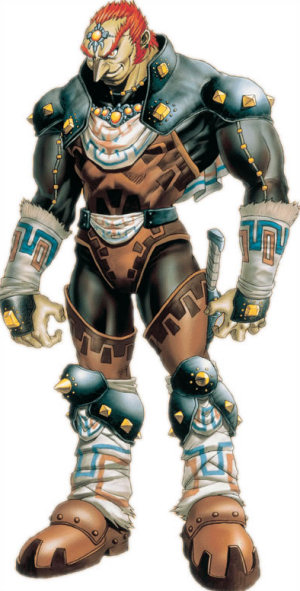



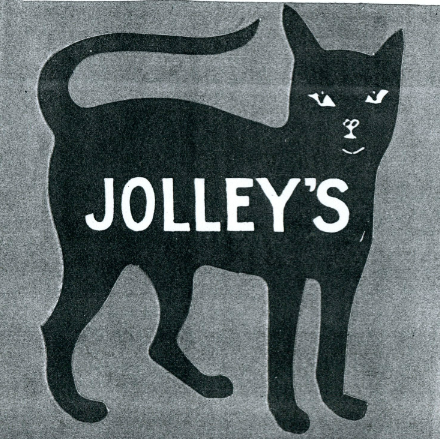
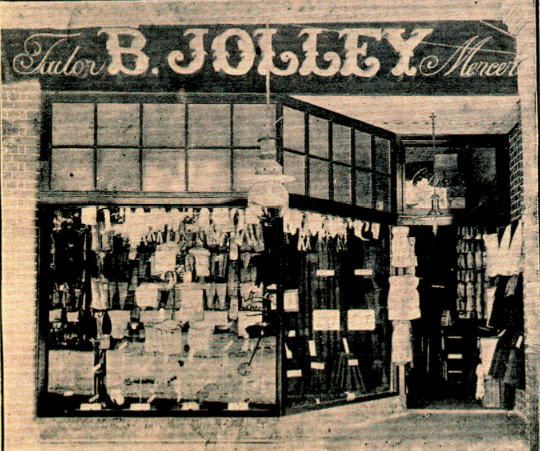
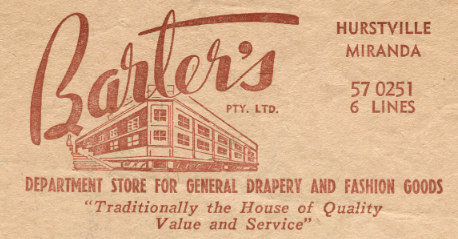

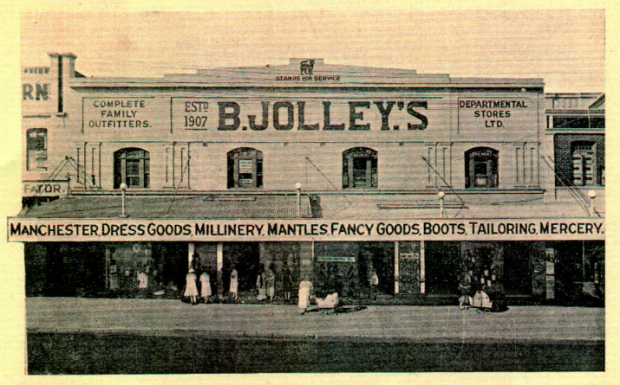


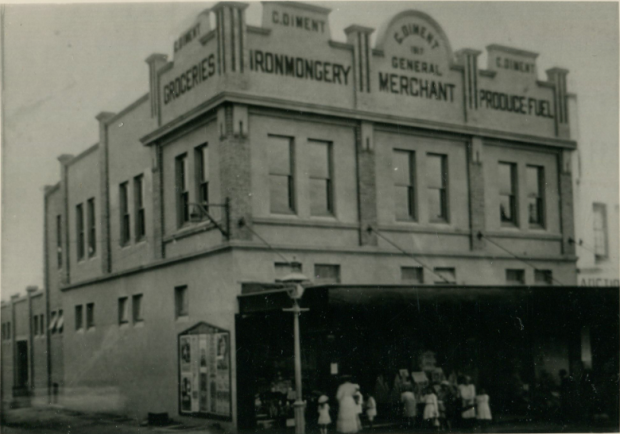

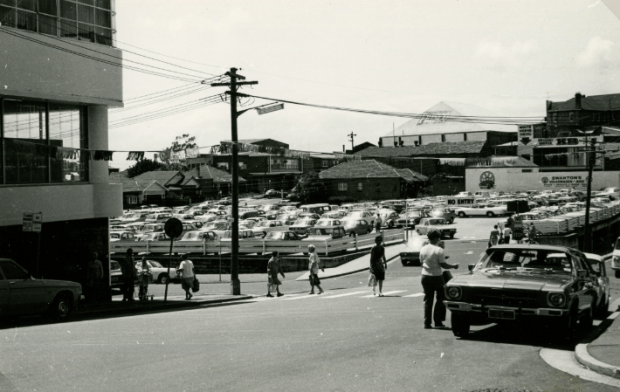

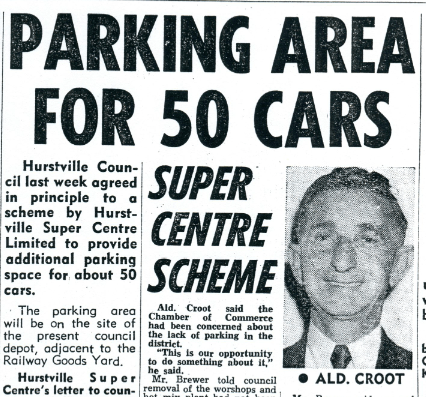
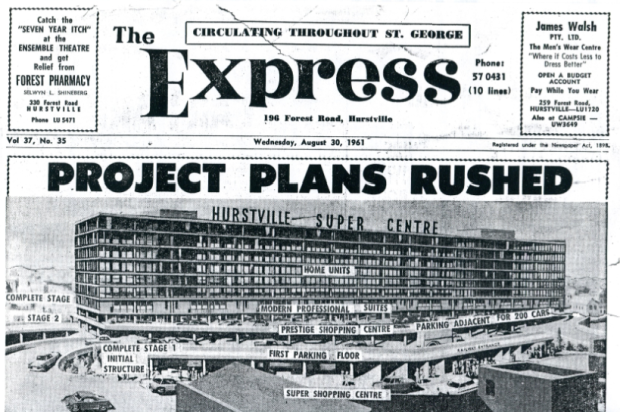
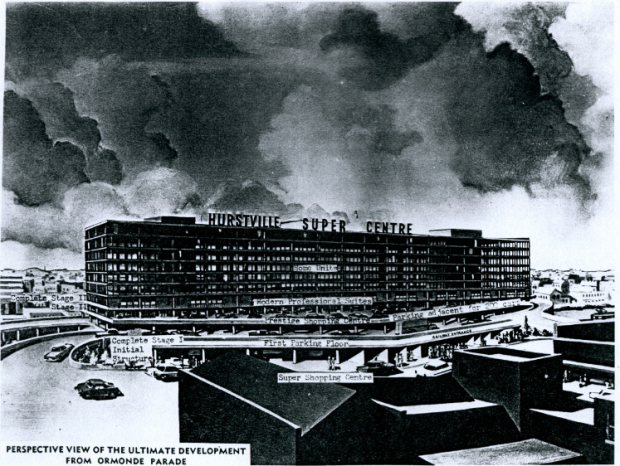

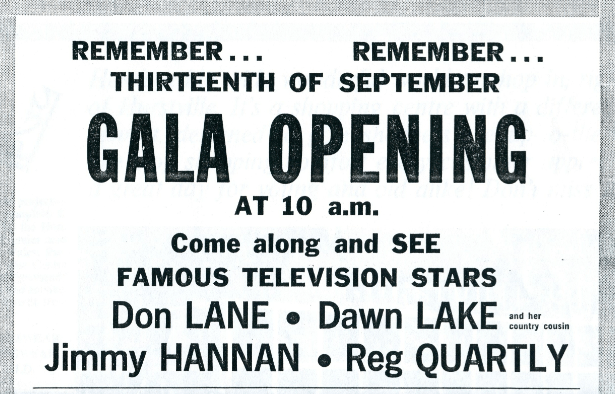

What an incredible story! I guess it is hard to cover 150 years in one blog post, but your effort is valiant – and very readable. http://hiddenhamilton.blogspot.com.au/
Wait’ll you get a load of part two!
Love IT…Thank you 🙂 as a Hurstville girl it makes great reading to discover our past 🙂
I recognize three of the four Famous Television stars at the Gala Opening on 13th September but who the hell is Reg Quartly?
I guess you had to be there, Peter.
Peter Reg Quartly was the famous “Uncle Reg”
I had no idea that the there had been such grand plans for the SuperCentre…well that fizzled out to a big disappointment
Can anyone expand of my list of tenants over the years of the Crosswalk Arcade (building on corner Crofts & Cross pictured above)? I have been told Franklins used to be in there before Westfield (it’s probably lurking behind those very walls pictured) and that Barbaras House & Garden may have been there in the late 70s/early 80s. Also there was at some point over the 80s/90s, the classic Crosswalk Cafe, Cosmetic Warehouse, JJs Fabrics, a hairdresser that had cane seating in their waiting lounge, Big Lee, a Vinnie’s type store ( a budget shoe store also occupied that major space just as you went in from the crofts ave side on the right – could have been Payless Shoes) Cash Converters. That’s as far as my memory serves me. Apparently there was a sewing production line on one of the upper floors for some major retailer. Can anyone shed anymore light on this topic?
Mick Simmons were above Franklins until the fire gutted the store in about 1975 I think.
Petta, Yes I remember Barbaras house and garden in the arcade. I used to buy those chocolate cigarettes in there as a young child.
Of course the chocolate cigarettes! Maybe my mum bought them from there for me too…that’s interesting I didn’t expect a shop like that to have sold those! Was it there into the 80s?
Yes it was. I remember going there when I was 4 and 5 years old, so that would of been 1985 and 1986. The chocolate cigarettes were at the counter. My mother has just said that when it closed she thinks it became Bing Lee.
Yes Bing Lee was there until at least the early 2000s after which they closed the whole arcade and remember that vividly and exactly where it was. I am racking my brain to remember BHG and am surprised you remember it as such a young age you have a great memory. In 85-86 I was 11-12, but obviously I didn’t go out there often enough. I will quizz my mother on that one. It wasn’t until 87-88 onwards when I started frequently visiting the cosmetic warehouse in there that I remember well. Lets stay tuned for the next instalment in this westfield story…hopefully we get all the nitty gritty detail.
What a great story. All the info being squeezed into this story. Good effort. I always find Hurstville pre-Westfield fascinating. I like comparing to see how Hurstville Is now with the past.
Thoroughly enjoyed reading this article – cant wait for the next edition. Very interesting. Growing up in the area I remember Hurstville as it was before Westfield. Thanks for posting.
Having grown up in Narwee, halfway between Hurstville and Roselands, in the ’60s, ’70s and ’80s this story is so interesting, and so funny! Brilliant writing!! I was actually at the opening of Roselands, albeit in my Mum’s belly (I was born a month later) – and my teen years were spent at both shopping centres, as the bus ran down our street from Hurstville to/from Roselands.
There was a milk bar at bottom of station steps opposite Barter’s.
I remember the milk bar! I went there with my mum in 1959💕
Just on the point of Roselands Centro. I can’t find any posts about the centre (besides Darell lea) I worked for the reject shop for 3 years and moved stores. When working there in what was called ‘the dungeon’ (the storage area) was markings on the wall like ‘coco pops’ and ‘rice bubbles’ all with codes underneath them. I’ve been told previously that where The Reject Shop and Priceline now stands used to be Franklins. I was wondering if anyone can confirm/deny that theory or give me any information on it. It would be believable that a Franklins used to be there but the size of the store would seem quite small compared to most Franklins I’ve been to i.e Rockdale and Miranda.
If anyone has any information that’d be great!
Thanks
I do remember a Franklins at Roselands…but I don’t remember where it was – it would have been somewhere right next to an entrance to a carpark (for convenience). As I haven’t been to Roselands for about 15 years, I have no idea where Reject Shop or Priceline are located within the shopping centre – can you enlighten me, please Liam – and it might jog my memory re Franklins.
TRS and priceline are on the bottom level. The best way to describe it is if you’re in the main carpark looking towards the shopping centre its next to the far left entrance.
I lived at Riverwood and it was so exciting to go to Hurstville on the bus with my mum. We always went to Barters and bought heaps and always went across the road and had lunch at Coles cafeteria. If I have to go to Hurstville now I feel like I’m in another country! So very sad.
I remember Barters at the railway steps.Main entrance on Forest Rd,side entrance halfway up the railway steps.I also remember the milk bar there,further around the cab rank.who remembers Thorburns mens hairdressors.
Loved reading this. I moved to Hurstvile around 1971 when my parents purchased J & C Hardy, so this is where I grew up. I now realise some of those memory snapshots I have are from shopping at Barters
Hi Marie,
I wonder if you remember anything about J and C Hardy, as I am pretty sure I am related to them. Was it a husband and wife business or two brothers do you know? Names? Would you know anything or anyone I could get in touch with? If so that would be amazing.
Thansk you so much,
Elyse (nee) Hardy
I grew up in the Hurstvliie area in the 50’s & 60’s ( Carlton ) just so many memories , fabulous however today it looks a totally different place .
I lived in Peakhurst so Hurstville was quite a big adventure. My dad worked in Diments (in the 50s and 60s and I worked in Coles as a Saturday/ school holiday casual. Coles cafeteria was bliss! We always felt so grown up being allowed to go there unsupervised.
Loved your article. Great writing style!
[…] Wayne, ‘Hurstfield – Act I: Genesis (1875 – 1975), Past/Lives of the Near Future, https://pastlivesofthenearfuture.com/2013/09/11/hurstfield-act-i-genesis-1875-1975/ , viewed 16 June […]